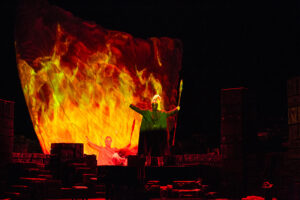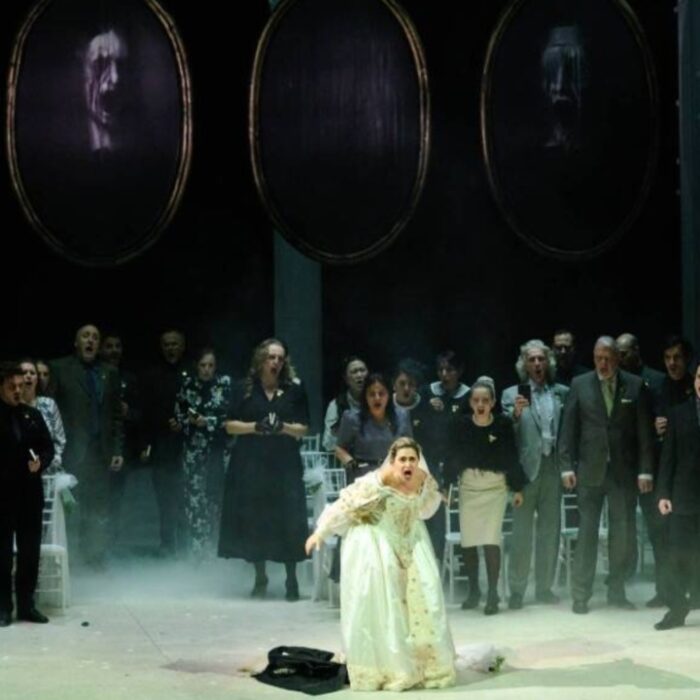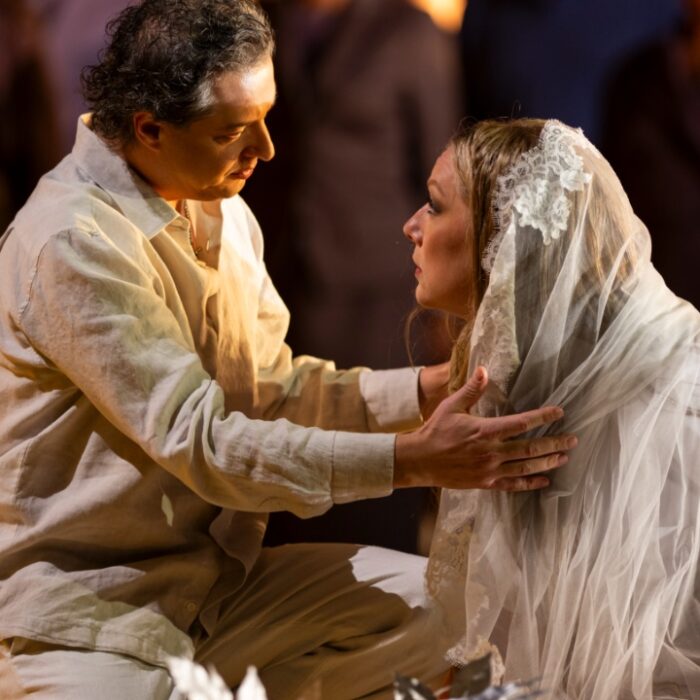
Deutsche Oper Berlin 2023-24 Review: Die Walküre
By Vincent Lombardo(Credit: Fotos von Bernd Uhlig, Kontakt: bernd.uhlig.fotografie@t-online.de)
Often after watching a perplexing rendition of “Das Rheingold“, critics and public alike might proclaim: “Let’s see what will happen tomorrow night. Let us hold our judgement until then, to see where all of this is going.” And then, Herheim’s “Die Walküre” began, proving to be the worst of the cycle.
The First Act brought us perhaps “another” opera, partially unrecognizable as to anything ever seen on the Wagnerian stage. Here again, right from the start, no theatre curtain rises, as there is none. Another unwanted, “invented” pantomime within the Prelude sets the tone, bringing us into the unhappy home of a lonely, frustrated woman and her unbearable son, “invented” – Hundingling, or “Little Hunding.” Sieglinde is seated, bent over the pianoforte, as she bangs the keyboard violently. Wagner’s cinematic music depicting Siegmund running for his life through the forest is put on stall; here Sieglinde is packing her bag to flee this nightmarish reality called home – a giant wall of suitcases menacing claustrophobia. There is a somewhat mature boy acting like a demented teen, desperately clutching his teddy bear substitute for his mother’s love. As a storm blows into the room, the thunder of Wagner’s raging timpani drives Sieglinde and her son to scream in anguish, only to seek refuge in sleep.
Examining Herheim’s Perspective
We might associate Herheim’s thinking as that of someone following various theories that began in Wagner’s own lifetime, believing that his music was the cause of nervous modernity pathologies, bringing on exhaustion, degeneration, and pervasion. This was supposedly caused by the length of the operas and the “pathological lack of rhythm” of the symphonic scores, bringing on stress and fatigue. In fact, Ludwig Schnorr, Wagner’s first Tristan, died at the age of 29 shortly after his debut performance. Wagner admitted in a letter that his own music had “driven the singer to the abyss.” It has also been said that women were supposedly susceptible to a disease referred to as ‘Wagnerianism’. The music was even inextricably linked to eroticism, and incest in Sieglinde’s case. Be this all the truth, it must be seen as a mistake to create a visual interpretation through today’s regietheatre as based on personal readings of Wagner’s intentions.
In this “Die Walküre”, an obsession stretches the dramatic out of proportion in an effort to defend parallel structures that, though related, lead one astray and certainly weaken what remains of Wagner. Thus, one might find it unacceptable that Siegmund, just moments after entering Hunding’s grotto, falls into a familial situation of pure mayhem. All attraction he will come to feel for Sieglinde is now filtered through Hundingling, at times portrayed as if he were already his son. The ‘dummy’ wields a knife as a little Nothung, yet instills no fear. He is more frightening with his pathetic teddy bear wrapped in his arms.
Sieglinde’s maternal ties to her son remain strained, almost a love-hate bond. For sure, the staging complicates all this – watch Sieglinde melt as Siegmund’s music possesses her, causing her to run to Hundingling joyously, tickling him with excessive maternity. At other times, she has long kissing bouts with her “saviour,” whom she realizes will be the destined one to pull the sword from the tree. All this creates a twisted, unbelievable new family trio. Siegmund appears no longer free to give himself to Siegliende – that is, not until she slits her son’s throat, undresses, and prepares to consume her incest upon the convenient bed-pianoforte. Through all this, poor Hunding wields a threatening rifle in his hand, has tantrums and fumes, yet only to remain an awkward, dispossessed father and husband right in his own home. This is the weakest shell-of-a-man Wagnerian character ever known. To flaying, agitated violins, the Act closes with Siegmund’s physical gesture of masculine victory, marked as triple forte for the woodwinds and horns, assuring one that a Siegfried is on the way. This is more than regietheatre .; it is an attempt to probe nuances so well-distant from the work at hand that what we see on the stage contains no “theme and variations,” but is a plagiarized opera making no attempts to hide the original. It is a sign of the times, and one must truly ask how much of this should the faithful opera goer continue to accept.
More Production Details
Act two holds few surprises. Wotan comes up through the prompter’s trap door, and one learns that he has just spoken to Erda, begging her to answer his question regarding the destiny of the Gods. He has a score of “Die Walküre” in his hands, but no pants on. He finds Siegmund’s sword on the floor, and puts it into Sieglinde’s hand, while she is sleeping with her brother-lover on the piano. Then he spots the teddy-bear, and drops it with disdain onto the dead Hundingling’s body. Wotan at the piano plays for two minutes as the real music begins, yet he never turns a page in the score. A smattering of wanderers with children and puppy dogs enter. Next, Hunding with his rifle accompanied by his rowdy group of thugs. Though distant from his house where Hundingling had his throat slit by his mother, he seems nsurprised.
Brünnhilde launches into her Valkyrie calls, and the wanderer ladies, really her sisters, don a Valkyrie helmet and spear. One of them is asked in a slapstick bit to bang her foot by accident, and limp off. Hunding remains, crawling to his son’s corpse, and cries as a baby. Fricka arrives through the pianoforte. This Goddess of Marriage does defend the institution, while Wotan seems open to incest and extra-marital affairs – “What was so wrong that was done by the couple that Spring united in love?” Wagner invites one to take sides in a dialogue wherein the diverse stances a married couple may take regarding their children develops. Soon, he will symbolically rape Brünnhilde, ripping off sleeves and skirt, which will be used for the next half hour as, among other things: a slain warrior is limply extended in the Valkyrie’s arms, only to become a seeming matador’s cape as images of the women in Valhalla who will charm him as a warrior slain in action, then as a tug-o-war rope pulled between them, and lastly, as a bedsheet to cover the sleeping Sieglinde.
A last gimmick choreography closes the act: on striking Hunding dead, Wotan prances about the stage, shaking his spear at five of Hunding’s mob, rifles aimed at him, and, on a triple forte brass chord, mowing them down. How much of this makes for a lively show, how much illuminates Wagner’s dramatic action? This is entirely up to those watching.
Musical Highlights
It must be stated that Wotan’s great monologue came off simply, directly, and as expected, the text held sway. This epic soliloquy in the style of Ancient Greek drama, or Shakespeare, too, needs little stage direction as it is Wotan who creates the images, and one’s imagination to follow. He is a messenger from the Antique theatre, where violent acts or tragic episodes happening off-stage are relayed to us through storytelling, one of the most immemorial forms of theatre we have.
The musically impressive “Walküren Ride” that opens Act three has perhaps never been executed well, as many of us may believe. Here, it is truly uninspired and distant from Wagner’s depiction of these dutiful Gods who have the double responsibility of choosing who will die in battle. Two Valkyrie are fighting over possessing a sheet, thought to be Brünnhilde’s skirt from the last scene. But no, these are simply pieces of white silk. The Valkyrie wave them as washerwomen, and we note that the lights in the auditorium are still on. They rip pages out of the score, and some hold these when they sing. As they cheer themselves, the lights upon us in the hall diminish.
They do seem to be having fun, but at our expense. Some Valkyries pick up dead soldiers fallen in battle, but when wrapped in gauze they look like silk cocoons or Egyptian mummies. One of the sisters must count eight on her fingers to realize that one is missing – yes, it’s Brünnhilde. And Hundingling is back; one feels as if to be in an Alain Resnais film, where characters enter and exist, almost surprising themselves. Brünnhilde plays the piano as Sieglinde emits the soaring melody that will conclude the Ring, “Redemption through Love.”
Brünnhilde is then banished from the Valhalla clan in operatic form. When all on stage returns to the opera, we too return to Wagner. The way in which Wotan admits to Brünnhilde and himself that he had to betray his word is emotionally draining. Here the wanderers return, and high upon the wall, the suitcases, observe the intense reality of the father-daughter strife: human love versus the entanglements of power. The wanders now wave a white sheet in a huge circle. Wotan’s spear tip turns red in incandescent heat. To Brünnhilde’s beautiful, lyrical heart-rendering phrase, now only a musical theme, “Inwardly true to the will which inspired this love in my heart, and which bound me to the Walsung”. She and Wotan hug. The wanderers are astonished, moved, but here become an obstacle. Wotan must relate to them all in this sad predicament. Why are they needed – to fold the white sheet that covered the pianoforte forming Brünnhilde’s rock?
The lid of the pianoforte is closed. White sheets that appear as Caspar the Friendly Ghost are pulled up, and projected images of flames infuse them. The piano opens and Sieglinde appears, in labour. Mime the doctor, Wagner’s image, delivers the hero-child, also receiving the sword in broken pieces. Again, Herheim prepares us for the opera to close. During “Rhiengold’s” end we saw Wotan plummet the sword into the tree. However, here one sees the arrival of Siegfried. This is impressive, but Wagner’s music is all about the fire that steadily encircles Brünnhilde, pure and prohibitive. It being her own wish as that of Wotan that only a hero will arrive to penetrate it. This is their hope, their unified solution to remove the guilt now harbouring in the consciousnesses. Therefore, why is Mime rocking ‘young’ Siegfried to sleep in his arms? Halfway through “Der Ring”, if nothing else, we again realize that the creative energies of Wagner reach us as totally mindboggling – his music and stage visions, here are often distorted.
Illuminating Cast
The orchestra played beautifully throughout, balanced as rarely heard, and compliments must be given to Maestro Runnicles. The singers, Siegmund (Daniel Frank), Sieglinde (Daniela Köhler) and Hunding (Tobias Kehrer) were a formidable trio, each one convincing musically and dramatically. Fricka (Annika Schlicht) was superb on the stage, and her rather huge voice made one ask if a Brünnhilde is in the wind. Wotan (Derek Welton) was totally praiseworthy in his portrayal of Wotan, ever moving, and singing fully with emotion. The eight Valkyrie (Flurina Stucki/Christiane Kohl, Felicia Moore, Maria Motolygina, Elissa Pfaender, Arianna Manganello, Karis Tucker, Nicole Piccolomini, Lauren Decker) were emotionally charged, singing well in ensemble, though weakened by the staging which did make them a bit too human, and overcharged most of the time. Credit must also be given to the actor-mime Eric Naumann, Hundingling, son of Hunding and Sieglinde, however unjustified it did seem, and with an overabundance of erratic emotion as the victim of an unhappy marriage.



